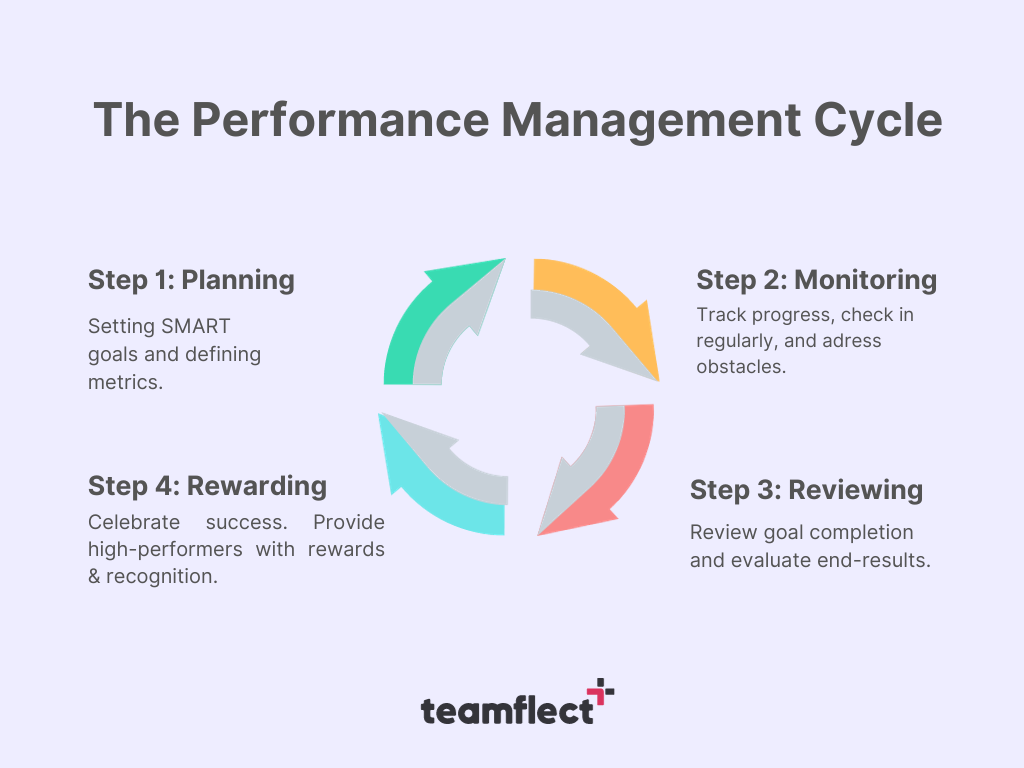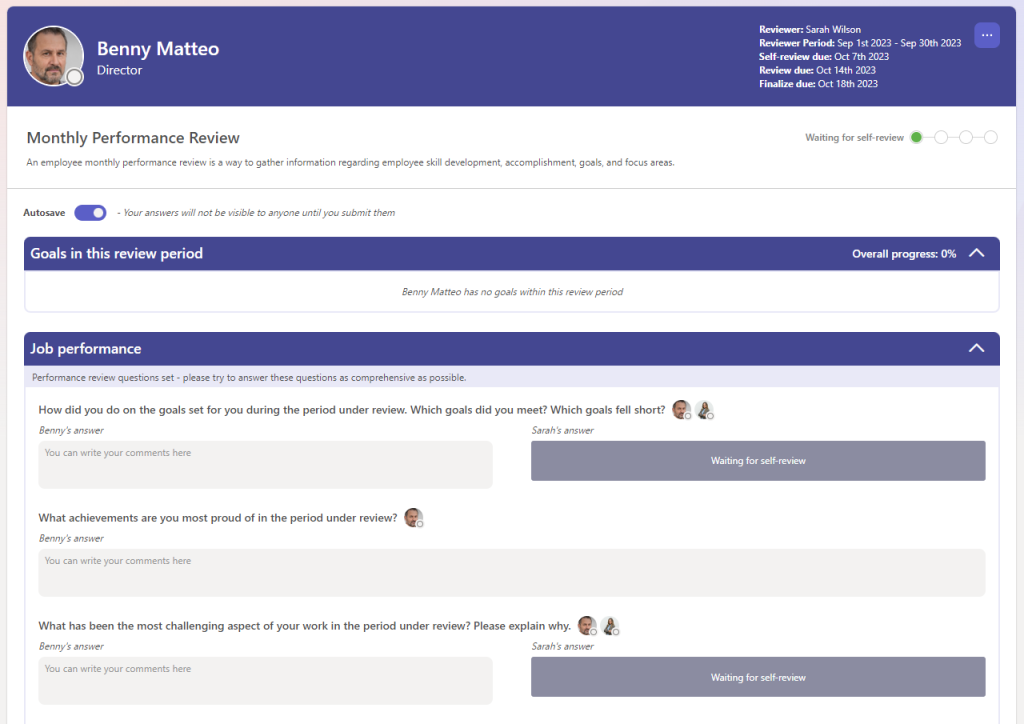The performance management cycle is a systematic series of steps that help ensure employees’ performance contributes positively to the business’s overall goals and objectives. It is a performance management model that allows organizations to achieve their goals effectively. Following a simple 4-step process, the performance management cycle aligns individual performance with the company’s direction, ensuring everyone is not just rowing, but rowing in the same direction.
The cycle typically unfolds in four stages: Planning, Monitoring, Reviewing, and Rewarding. Each stage has its own significance, and together, they create a holistic approach to managing and enhancing performance.
That being said, one of the biggest mistakes a leader can make with the performance management cycle is to view it as a linear process. It’s not just about annual reviews or filling out forms; it’s a continuous process that focuses on growth, feedback, and recognizing achievements.
n the following sections, we’ll break down each stage of this cycle, giving you the insights and tools you need to implement it effectively in your own workspace. Whether you’re looking to revamp your current performance management system or starting from scratch, understanding the performance management cycle is your first step towards fostering a high-performance culture.

Table of Contents
The Performance Management Cycle: Stage-By-Stage
We can’t give you the definition of the performance management cycle without giving you tips on how you can manage each and every step of it. As we elaborate on each stage of the performance management cycle, we will be showing you how you can use performance management software to manage each stage effectively.
While there are plenty of performance management tools that can help you in this process, the tool we will be covering is Teamflect, a software solution designed specifically to be a part of Microsoft Teams, and it is the highest-rated option in the Microsoft Teams ecosystem. So without further ado, let’s dive right in.
Step 1: Planning
Every great performance management cycle starts with goal setting and overall planning for the review period. This includes setting goals at organizational, departmental, and individual levels, determining key performance metrics, and of course, allocating resources to make sure your team is ready for the review period.
Goal Setting: This is the cornerstone of the performance management cycle. Here, objectives are established for individuals and teams, aligning with the broader goals of the organization. These goals should be SMART: Specific, Measurable, Achievable, Relevant, and Time-bound.
Expectation Clarification: Employees must understand what is expected of them. This includes not just the “what” but the “how” – the behaviors and values that the organization cherishes. Before the review period starts, the metrics across which they will be evaluated should be clear and established.
Resource Identification: Part of planning is ensuring that employees have the necessary tools, training, and support to achieve their goals. This sets the stage for success from the outset.
How to set goals inside Microsoft Teams

To set goals at any level inside Microsoft Teams, all you have to do is integrate Teamflect and access the goals module. There you can customize each and every aspect of a goal to make sure it fits the SMART criteria.
Whether you are setting an individual, departmental, team, or company goal, you can input custom goal measurement criteria as well as create related and parent goals for a cascading structure.
Step 2: Monitoring
The performance management cycle should never be a series of linear steps. It includes continuous performance management. That means, once you set your goals, you need to be checking in with your goal owners on a regular basis through meetings and offer feedback where necessary.
The monitoring stage is also where leaders address any potential challenges and roadblocks that may arise.
Progress Tracking: Regular check-ins are essential to monitor employee progress towards goals. This isn’t about micromanagement, but about providing support and adjusting strategies as needed.
Feedback Provision: Continuous feedback is a key element of this stage. It helps in identifying areas of improvement and acknowledging achievements, keeping employees motivated and on track.
Adjustments: Monitoring allows for timely adjustments to goals or methods, adapting to any changes in the organization or market conditions.
Monitoring goals inside Microsoft Teams

Having regular check-in meetings is an absolute must throughout the performance management cycle if you want to make sure your team’s goals stay on track. These meetings will keep your team engaged and your goals visible.
To make sure you are achieving maximum productivity, engagement, and visibility in your meetings, you can use Teamflect’s comprehensive meeting agendas, as well as other meeting features. You can view the goal progress of each meeting participant, create tasks on the spot that are aligned to those goals, and recognize those on track.
Stage 3: Reviewing
The end of a performance management cycle is marked with a performance review. While the optimal performance review frequency changes from one company to the other, having anywhere between two to four performance reviews per year can be recommended.
Performance Evaluation: In this stage, employees’ performance is assessed against the set goals. This evaluation should be objective, fair, and based on the criteria established during the planning stage. As employees are going into their reviews they should know just what exactly is expected of them.
Documentation: Keeping a record of performance assessments is important for transparency and for future reference in career development discussions. If you have a strong HR analytics tool you can analyze review results effectively.
Talent Development: Each performance review you conduct should have the aim of developing your talent at its heart. You can achieve this through creating employee development plans or other succession planning methodologies such as the 9-box talent grid.
Conducting digitized performance reviews

There is a reason performance reviews get a bad reputation. That reason is the fact that they are often executed in a manual and clunky way. That should have no place in your performance cycle. While Excel or Word performance review templates are a common practice, the best way to end your performance management cycle is through digitizing your reviews.
You can conduct entire performance reviews inside Microsoft Teams, using Teamflect’s customizable review templates. You can either pick from an extensive library of review templates or create your own with ease.
You can integrate employee development plans, and the 9-box grid into your reviews to focus on growth and succession planning. Once your reviews are complete, you can analyze results through a dynamic analytics dashboard.
Stage 4: Rewarding
While “Rewarding” is the fourth step in the traditional definition of the performance management cycle, leaders shouldn’t make the mistake of waiting until the end of the review period to recognize and reward their team. Celebrating success and regularly recognizing high-performers should be something practiced throughout the review period.
Recognition: Acknowledging and rewarding high performance is crucial. This can be in the form of bonuses, promotions, or public recognition.
Motivation Enhancement: Rewards serve as a motivational tool, not just for the rewarded employee but also for their peers.
Alignment with Organizational Goals: Effective rewarding aligns individual achievements with organizational objectives, reinforcing the importance of contributing to the bigger picture.
Implementing rewards and recognition in Microsoft Teams

If you want to implement an employee rewards and recognition program over Microsoft Teams, you can take advantage of Teamflect’s recognition module with customizable recognition badges, a real-time recognition feed, and leaderboards you can toggle on and off.



